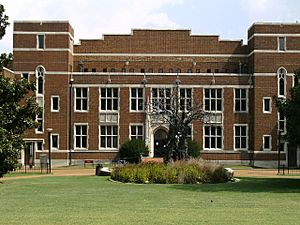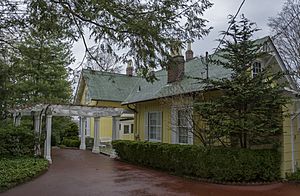Newington-Cropsey Foundation facts for kids
The Newington-Cropsey Foundation (NCF) is a special organization in Hastings-on-Hudson, New York. It's a nonprofit, which means it doesn't aim to make money. Its main goal is to protect and share the artworks of Jasper Cropsey. He was a famous painter from the Hudson River School, an art movement known for beautiful landscape paintings. The foundation also supports art that looks like real life, called representational painting and sculpture.
Barbara and John Newington started the NCF in 1977. They wanted to collect and share Jasper Cropsey's art. Barbara is Cropsey's great-granddaughter. The foundation also promotes other art that is not abstract.
The NCF lets people visit its special places for free. These include Ever Rest, which was Jasper Cropsey's last home and art studio. There's also the Gallery of Art Building, a museum just for Cropsey's works. Both places are right next to each other in Hastings-on-Hudson.
Contents
What the Foundation Does
The Newington-Cropsey Foundation wants to keep alive the artistic and moral ideas of Jasper Cropsey and the Hudson River School. They hope to bring back some of the feeling of beauty and stability from the 1800s. The foundation also supports art that shows things as they really look.
This organization is privately owned. Barbara Newington is the current chairman. Adelia C. Rasines is the executive director. Anthony Speiser is the foundation's director. All three also help manage the foundation.
The NCF gives money to artists who create representational art. They also offer classes for sculptors who make classical works. The foundation publishes a magazine called American Arts Quarterly. This magazine focuses on art that is not abstract.
The NCF has a large collection of Cropsey's paintings. They own about 100 oil paintings and 30 watercolor paintings. The foundation is known as the top expert on Cropsey's art.
History of the NCF
How It Started
After Jasper Cropsey passed away in 1900, his wife Maria lived in their home, Ever Rest, until 1906. Their granddaughter, Isabel, then inherited the house. Isabel started buying back some of Cropsey's paintings. Isabel and her husband, William Steinschneider, lived there and raised their daughter, Barbara. William was the mayor of Hastings for many years.
Isabel died in 1958, and William in 1970. Barbara, their daughter, inherited Ever Rest. She married John Newington. Barbara and John actively collected Cropsey's paintings until the 1980s. At that time, Cropsey's art was still affordable. They created the Newington-Cropsey Foundation in 1977. They were concerned about the direction modern art and culture were taking.
Barbara Newington is now the foundation's chairman. She is a generous supporter of many causes. She is also Jasper Cropsey's great-granddaughter.
Around 1977, the foundation traded land with the village of Hastings. The NCF gave the village land and money for a garage. In return, the NCF received a 6-acre piece of land. This land used to be a town dump. The NCF planned to fix up the area. They wanted to make it look like a Cropsey painting.
In 1979, the NCF loaned items for an art show. The show was called "An Unprejudiced Eye." It featured Cropsey's works at the Hudson River Museum. This exhibit celebrated Hastings' connection to Cropsey and its 100th anniversary.
In the late 1980s, the NCF began building an art complex. It included three buildings, a pond, and a garden. The first building, the New Studio, opened in 1990. It showed paintings by another Hudson River School artist, Worthington Whittredge. The plans also included a museum, which opened later.
During the planning, the village's historical society asked for a pause. They wanted to check for old remains in the area. The site was important because early industries had been there. The NCF paid for an archaeological study. The construction was approved after the study was done.
The Gallery of Art officially opened on October 16, 1994.
Sculpture Garden Project

In May 1997, the foundation started a project with Vanderbilt University. They planned to create a sculpture garden on the university campus. It was called the "Garden of Great Ideas."
Students from the NCF's Academy of Art created bronze sculptures for the garden. The NCF hoped to place many sculptures on college campuses. This would connect learning with art. The NCF had already given a sculpture called Bill of Rights Eagle to the university. This sculpture was made by Greg Wyatt, who directed the NCF Academy of Art. The NCF planned to donate more sculptures over the next few years. The final sculpture was Tree of Knowledge by Wyatt.
Some professors at the university had concerns about the art program. They felt the sculptures did not fit the school's goals for quality and variety. They noted that all the sculptures were made of the same material and had similar ideas. Also, no Vanderbilt students were among the artists.
The sculpture Tree of Learning caused the most discussion. Some professors thought it looked "boring" and like a "dead tree." A university official agreed it looked dead. He asked Wyatt to add leaves and buds to the sculpture. However, he defended the program overall. He noted that the student artists came from different backgrounds.
More Recent History
Joseph Petrovics, a sculptor, taught at the Newington-Cropsey Foundation Academy of Art starting in 1993. He created the National Iwo Jima Memorial and the FDNY memorial wall.
From 1994 to about 2005, the NCF hosted the Hudson Valley Art Association's yearly art show. Barbara Newington and the foundation had always supported this art group.
In 2006, the NCF helped create a Christian film called Lost Letters of Faith. It was a story about King Abgar of Edessa. Another film project, Cradle of Genius, explored how composers like Brahms and Puccini found inspiration.
From 2015 to 2017, Greg Wyatt placed a series of sculptures at the Boscobel House and Gardens. This place is in Garrison, New York. The garden now has ten bronze sculptures of important Hudson River School artists. The NCF donated these sculptures. Boscobel was chosen because it is in the Hudson Highlands. This area was a favorite subject for the Hudson River School painters. Each sculpture includes a short story about the artist. They also show parts of the artists' famous paintings.
Ever Rest and the Gallery of Art are part of the Hudson River School Art Trail. This trail is a project of the Thomas Cole National Historic Site.
Ever Rest: Cropsey's Home
Ever Rest was the home and studio of Jasper Cropsey. It is a 4.5-acre site managed by the foundation. The address is 49 Washington Avenue in Hastings. You can visit the home for free tours by making an appointment. It is a historic house museum.
The house is a bright yellow cottage with a special style called Carpenter Gothic. It is listed on the National Register of Historic Places. Cropsey lived here from 1885 until he passed away in 1900. The home displays about 40 to 50 of Cropsey's artworks. Many of these are watercolors.
Gallery of Art: The Museum
The Gallery of Art building is located below Ever Rest. It is about 60 feet down in a ravine. From there, you can see the Hudson River and the Palisades. The museum is behind a parking lot for the Hastings-on-Hudson train station.
This area has a few buildings. One building holds the office for American Arts Quarterly. This magazine focuses on realistic painting from the Hudson River area. Its circulation is about 3,000 copies. The top floor has a library with about 4,000 books. These books are about 19th-century painting.
The museum shows paintings and sculptures by Cropsey and other 19th-century artists. It has about 75 of Cropsey's paintings. Many show scenes from England and Rome, where Cropsey traveled. It also has allegorical works from the 1850s. You can visit the museum for free tours by appointment.
The museum building is yellow and has a style called Gothic Revival or Palladian style. It was built in 1994. The building and its surrounding landscape cost about $4 million to build. It was designed to look like an old building. It aims to bring back the beauty and stability of the 1800s. The building uses ideas from classical architecture. For example, sunlight shines onto the rotunda's floor.
An art critic from New York Times thought the building was "inappropriate." She said the main gallery had Cropsey paintings hung too high. They were also poorly lit and not labeled. She felt Cropsey's works were easier to see at Ever Rest.
Outside the Gallery
The outside of the building has special iron doors and a canopy. It also has arches and turrets. The park area around the gallery has a duck pond with duck houses.
Inside the Gallery
The main round room, called the rotunda, was designed like the Pantheon in Rome. Its floor was inspired by the Piazza del Campidoglio in Rome. The rotunda also has carvings that show scenes from Hudson River history. Around the walls of the rotunda, there is a quote from Cropsey:
Ambition may be praiseworthy when its aim is that of excellence and the fountain from which it draws nourishment that of almighty wisdom.
The main art gallery is an eight-sided room. It has maroon wallpaper above dark wood panels. The ceiling is made of timber. A large oak staircase leads to the second floor. This room displays Cropsey paintings from floor to ceiling. The lights are kept dim, which makes the paintings glow. The room was designed to look like old Hudson River houses, such as Ever Rest. The building also has sculptures and religious statues. One is a copy of an inscribed stone with a message from King Abgar of Edessa to Jesus Christ.
The building has a research library. It focuses on Hudson River School art and artists. The organization wants it to be the best resource for artists of this school in Westchester County. The space also has a gallery for temporary shows. These shows feature works by modern representational artists.



